Portfolio
| Home | In-class Exercies | Assignments | Project | Project: Part I | Project: Part II | Project: Part III |
The Carbon Footprint: Tracing the Impact of US Energy Production on Climate Change
Introduction
As we navigate the pivotal decade of 2020, our planet stands at a crossroads of climate challenges and energy transformation. “The Carbon Footprint: Tracing the Impact of US Energy Production on Climate Change” is an explorative journey through the intricate relationship between America’s energy choices and the carbon footprint they leave behind.
The year 2023 is poised to be inscribed in history as the warmest year on record, edging past the critical 1.40°C global temperature increase above pre-industrial levels—a threshold that brings us perilously close to the 1.5°C limit set by the Paris Agreement to avoid the most catastrophic effects of climate change (World Meteorological Organization, 2023). The exceptional global heat experienced in the first three quarters of the year underscores the accelerating pace of climate change, with NASA’s Earth Observatory highlighting the summer of 2023 as the planet’s hottest since records began in 1880.
Amidst this warming, the United States, a historical leader in industrialization, stands as a significant contributor to global CO2 emissions. The project dissects half a century’s data, revealing a trend where CO2 emissions have escalated to 419 parts per million by October 2023, up from 417.06 ppm in the previous year, signifying an alarming increase of about 50% in atmospheric CO2 in less than two centuries (Scripps Institution of Oceanography, 2023).
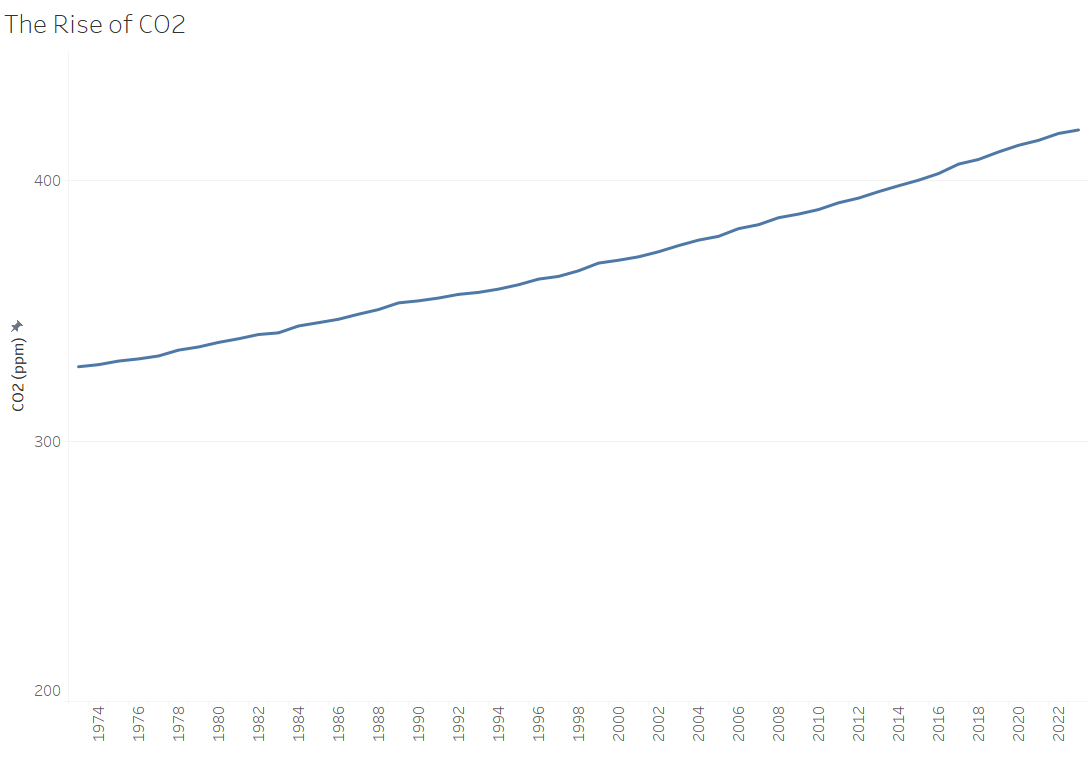
My story delves into the historical trends of energy consumption, tracing back to the mid-19th century when the UK led in emissions, to the current landscape where developing nations and industrialized countries jostle for the top emitter status. The narrative unfolds to reveal the shift in the US energy mix from 1973 to 2023, reflecting a promising increase in renewable energy yet juxtaposed against the stark reality of rising CO2 emissions. This paradox of progress lays bare the complexity of the energy-environment nexus.
The carbon cost of producing electricity is scrutinized through the prism of carbon intensity, comparing the CO2 emissions per kilowatt-hour of energy produced from coal, petroleum, natural gas, biomass, and renewable sources. This analysis serves as a cornerstone of my exploration, considering the International Energy Agency’s projection that global CO2 emissions from energy use and industry could potentially peak this year, marking a defining moment in the trajectory of global warming (International Energy Agency, 2023).
As we chart the future, this project will not only spotlight the United States’ current energy consumption choices but also propose a path forward. The US’s influence on the global stage as a major CO2 emitter means that any significant shifts in its energy policy could sway the international climate change battle. The project is a call to action, urging a transition towards cleaner energy, not just for environmental imperatives but as a strategic maneuver in the geopolitical arena, where energy independence and technological leadership are increasingly synonymous with global influence.
In this narrative, we are not mere spectators; we are participants with the power to influence outcomes. Through rigorous research, interviews with academia and industry experts, and comprehensive data visualization, “The Carbon Footprint” seeks to empower, educate, and engage a diverse audience in the vital conversation on climate change and sustainable energy practices. My journey through this data story is a testament to the power of informed choices and the indelible impact they have on our planet’s future.
Change in US Energy Consumption Mix 1973-2023
In the grand tapestry of the United States’ energy narrative, the years between 1973 and 2023 stand out as a period of profound transformation. Over these five decades, the energy consumption mix of the nation has undergone a metamorphosis that reflects not only technological innovation and economic shifts but also a burgeoning consciousness of environmental stewardship and sustainability.
In the wake of the 1973 oil crisis, the United States, like much of the industrialized world, was jolted into the reality of its energy vulnerabilities. The nation’s energy portfolio, then heavily skewed towards oil and coal, began a slow yet decisive pivot. The pie charts representing this era show a domination of fossil fuels, with renewables barely a sliver of the overall energy consumption mix.
Fast forward to 2023, and the landscape has been reshaped. The emergence of renewable energy sources—solar, wind, hydroelectric, and biomass—has redefined the energy consumption mix. This shift is captured vividly in my project’s comparative visualizations, which juxtapose the solid, almost monolithic presence of fossil fuels in 1973 with the burgeoning diversity of energy sources in 2023.
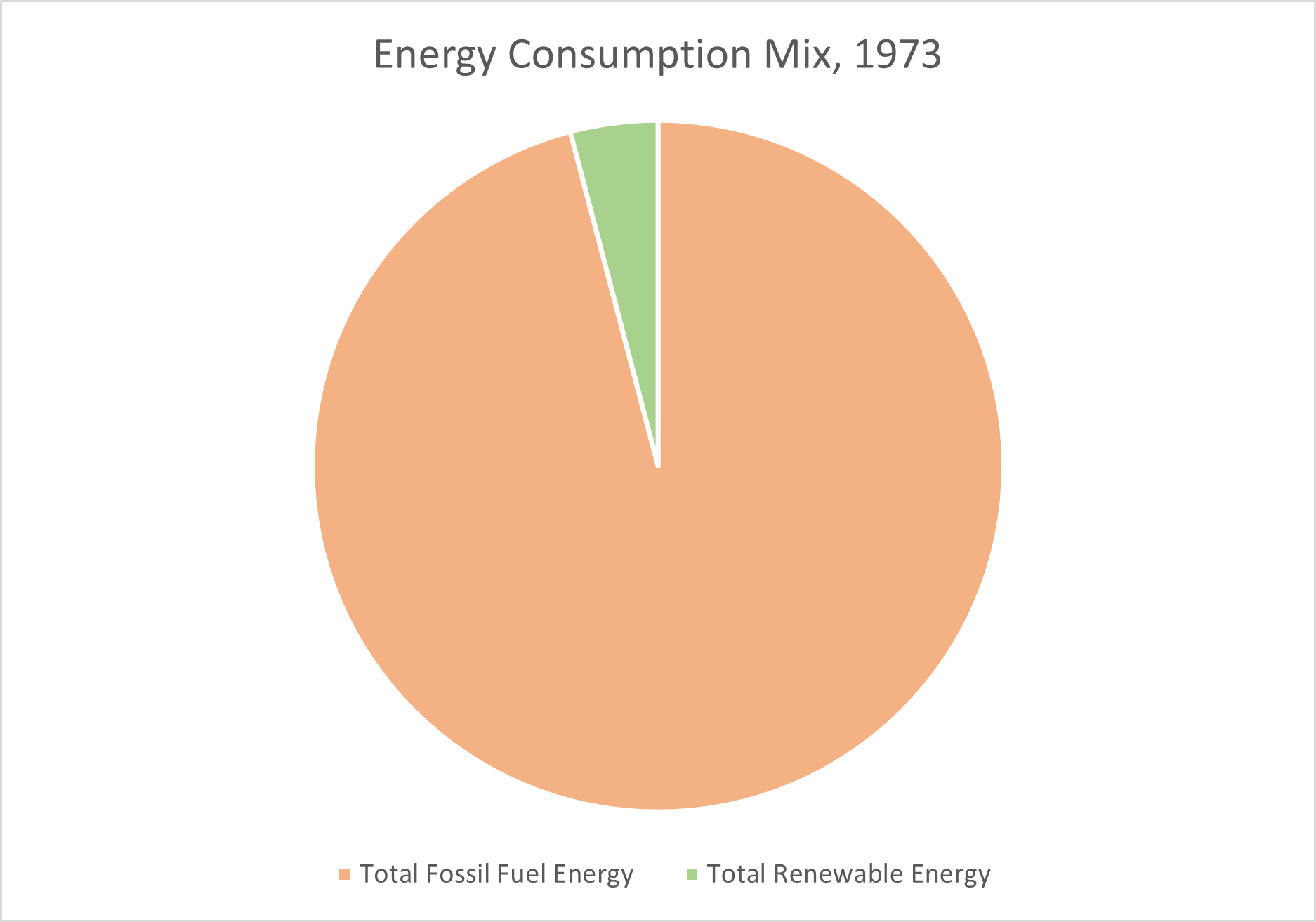
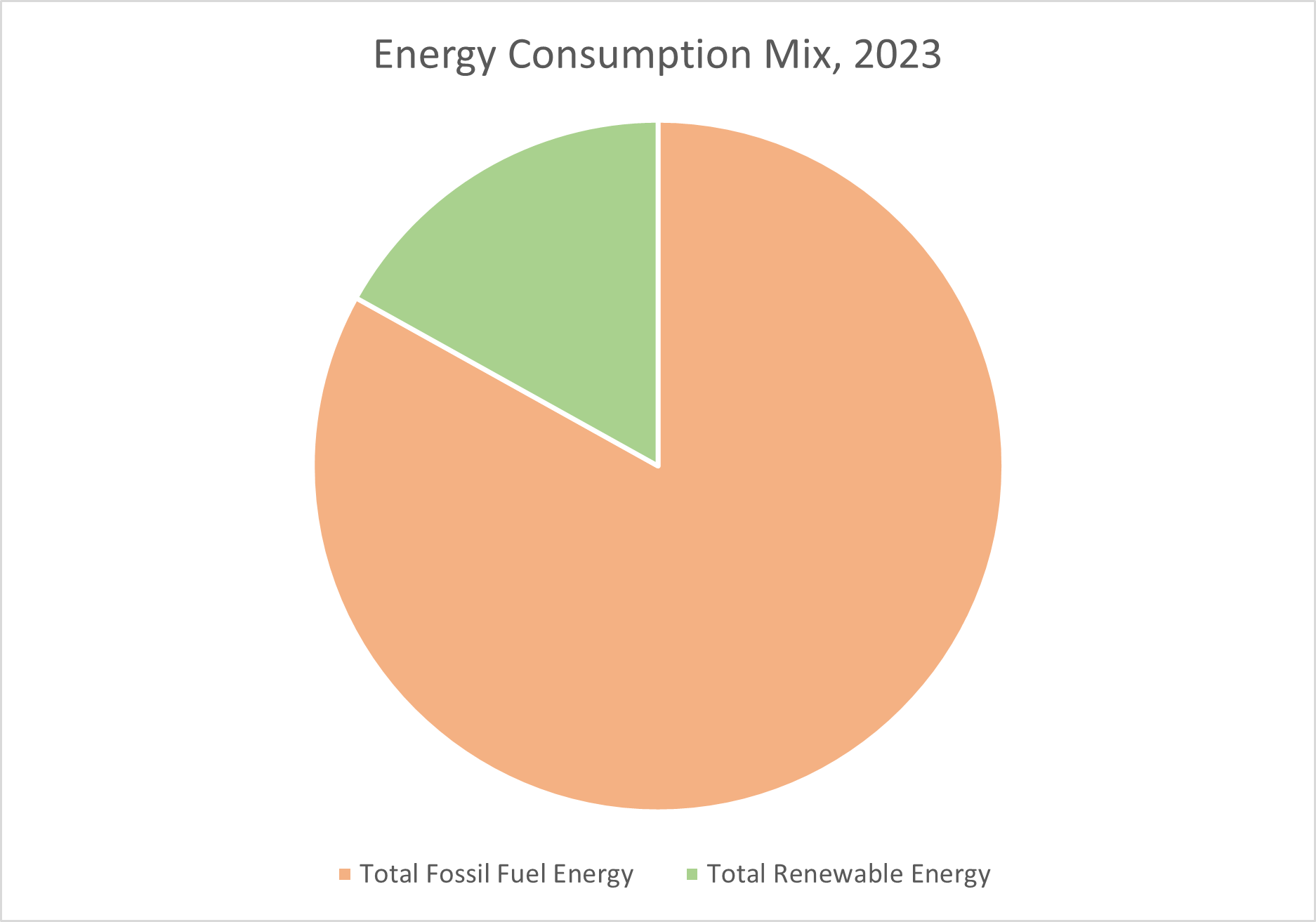
Yet, this change did not occur in a vacuum. It has been propelled by a confluence of factors: the advancement in renewable technologies, decreasing costs of production, policy incentives, and a palpable shift in public sentiment towards green energy. The US Energy Information Administration (EIA) has chronicled this transition, providing granular data that reveals an economy in the midst of an energy renaissance (U.S. Energy Information Administration, 2023).
However, the story is not one of unqualified success. Despite the notable increase in renewable energy’s share, it is juxtaposed against the backdrop of an ever-increasing appetite for energy. The total energy demand has surged, and fossil fuel consumption, though a smaller percentage of the mix, remains substantial in absolute terms. The consequence is a continued rise in CO2 emissions, a sobering reminder that the path to a truly sustainable energy future is fraught with complexity and inertia.
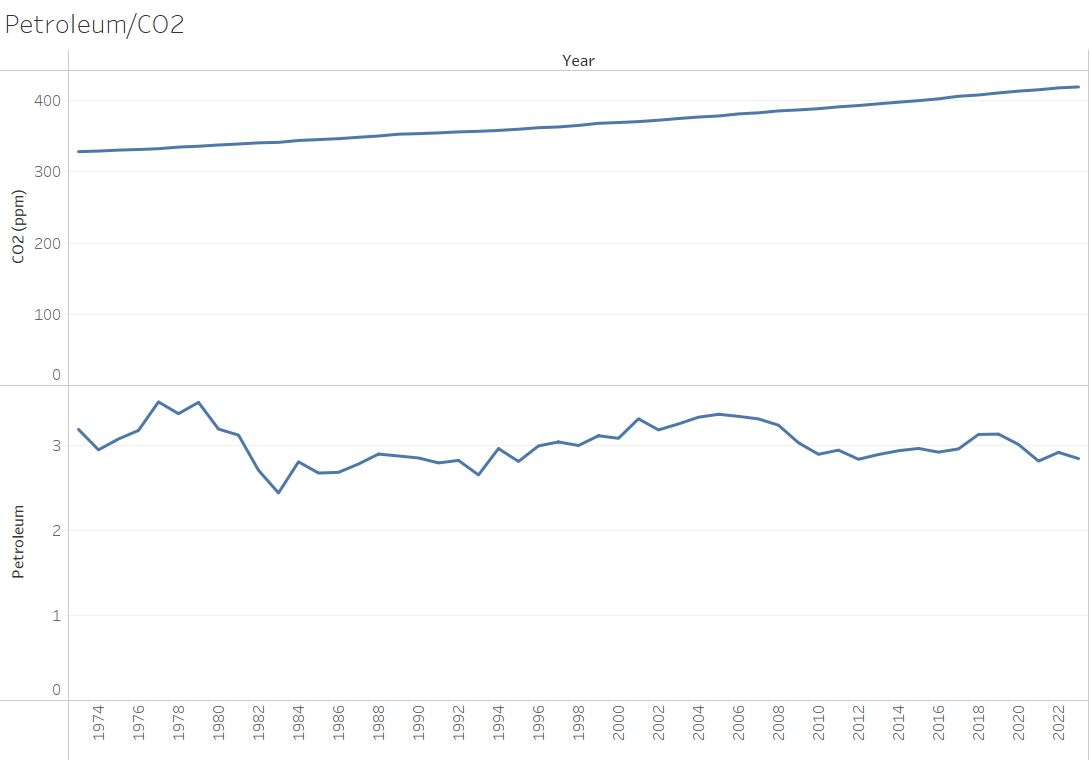
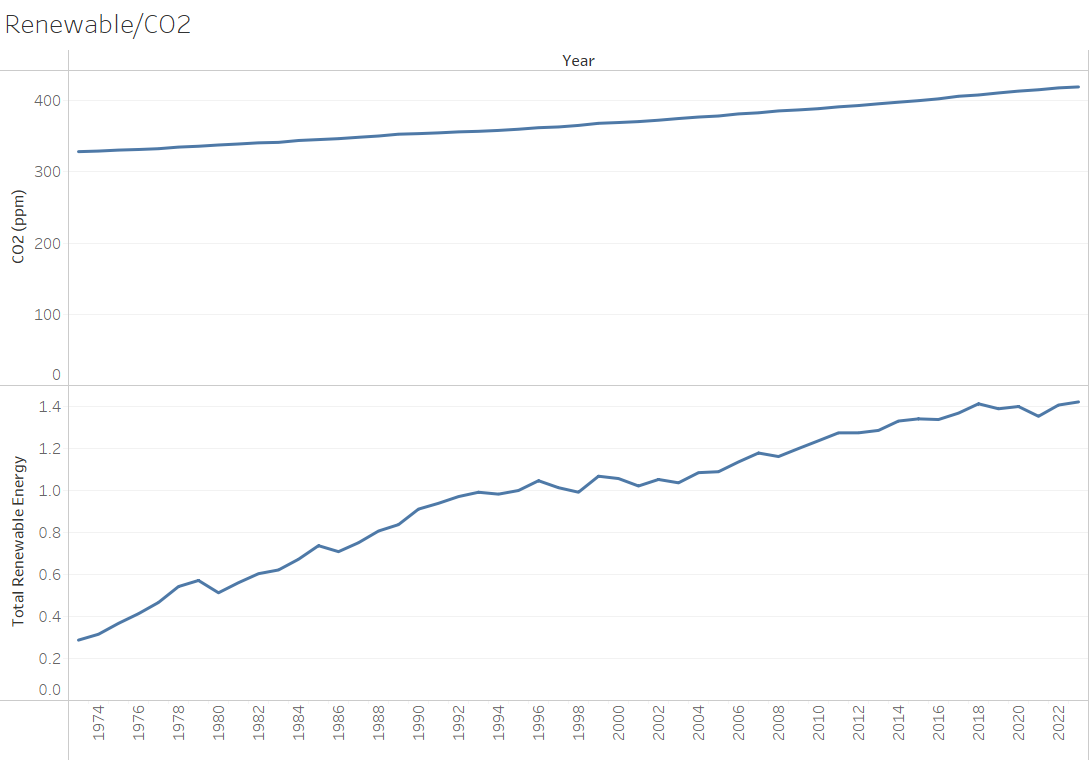
The project’s visualizations aim to render this complex data into a comprehensible narrative. We not only see the change in percentages but can also explore the underlying numbers. Our story seeks to elucidate the dichotomy of progress: a nation that has made strides towards a greener energy mix but still grapples with the legacy of its carbon-heavy past.
As we stand in 2023, the cross-section of energy consumption in the US is a mosaic that tells of progress, challenges, and the potential for a reimagined energy paradigm. It is a stark illustration of the nation’s journey from a fossil-fuel-dependent past to a future that, while still uncertain, has the potential to be powered by the winds, waters, and sun.
The Carbon cost of producing electricity
The cost of electricity goes beyond the mere economic expense consumers pay; it encompasses the environmental impact of production, predominantly quantified in terms of carbon emissions.
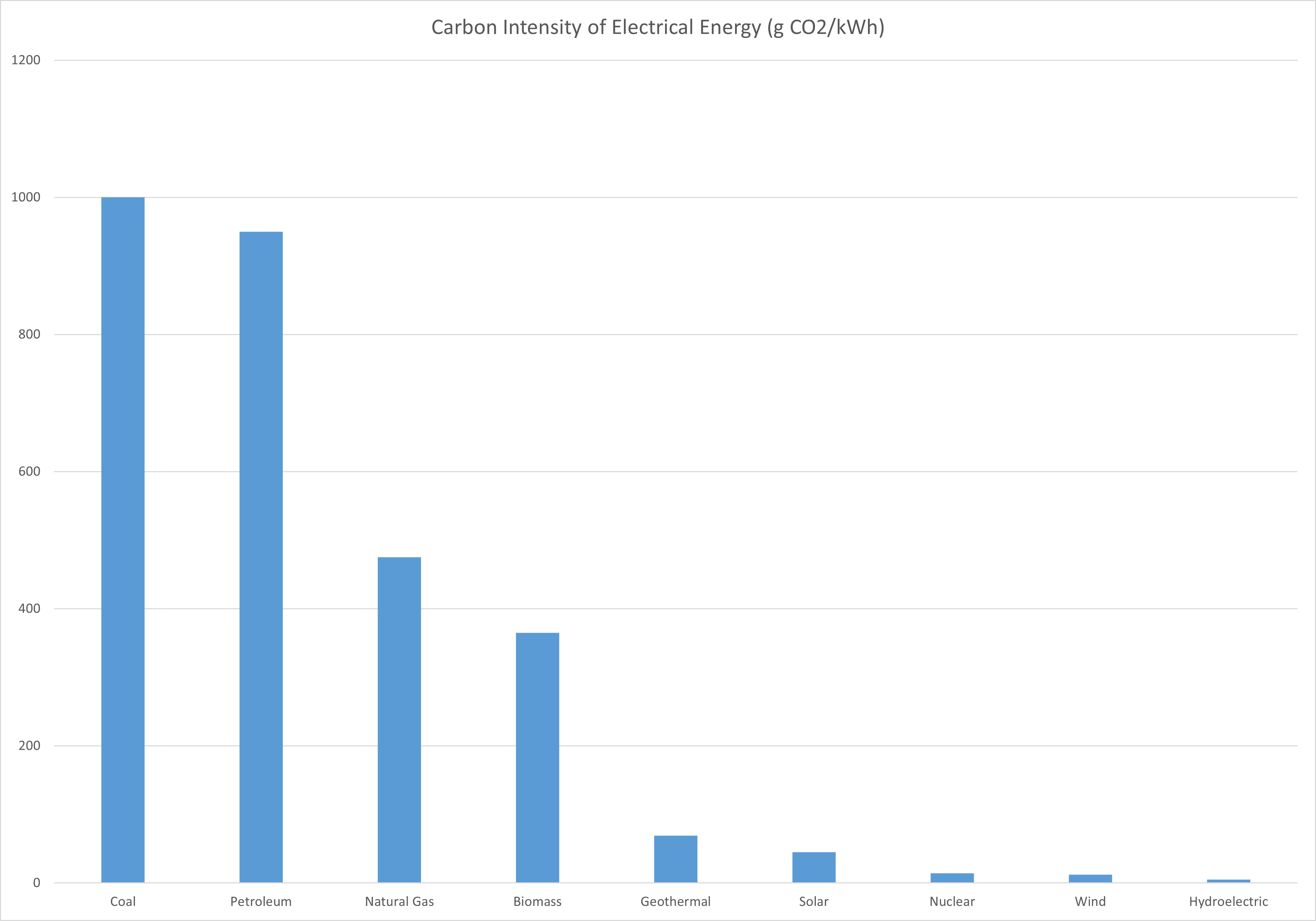
This “carbon cost” is a critical measure in understanding the climate implications of our energy choices. From 1973 to 2023, the United States has witnessed a significant evolution in the carbon intensity of its electricity production—a narrative that my project unfolds through compelling visualizations.
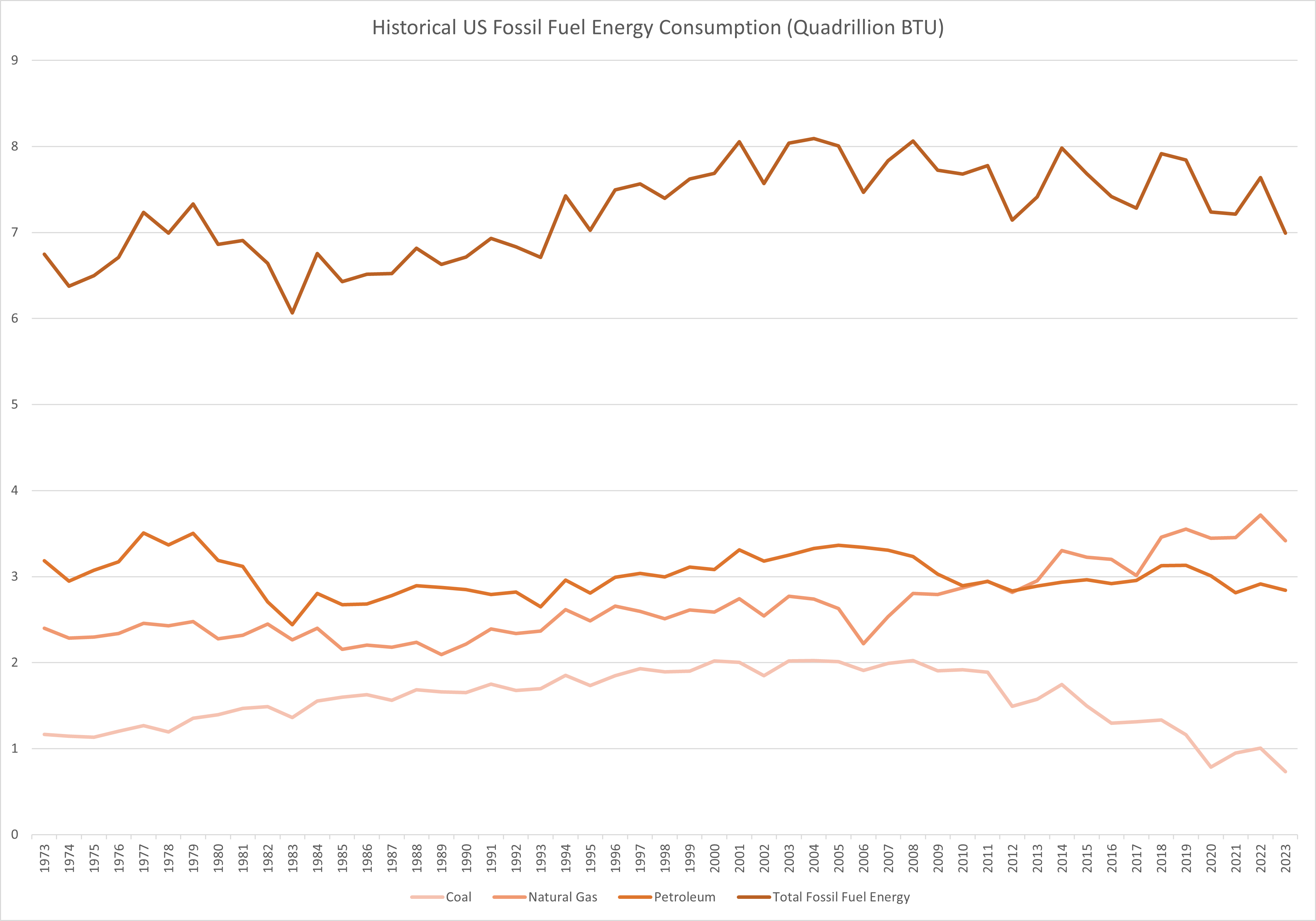
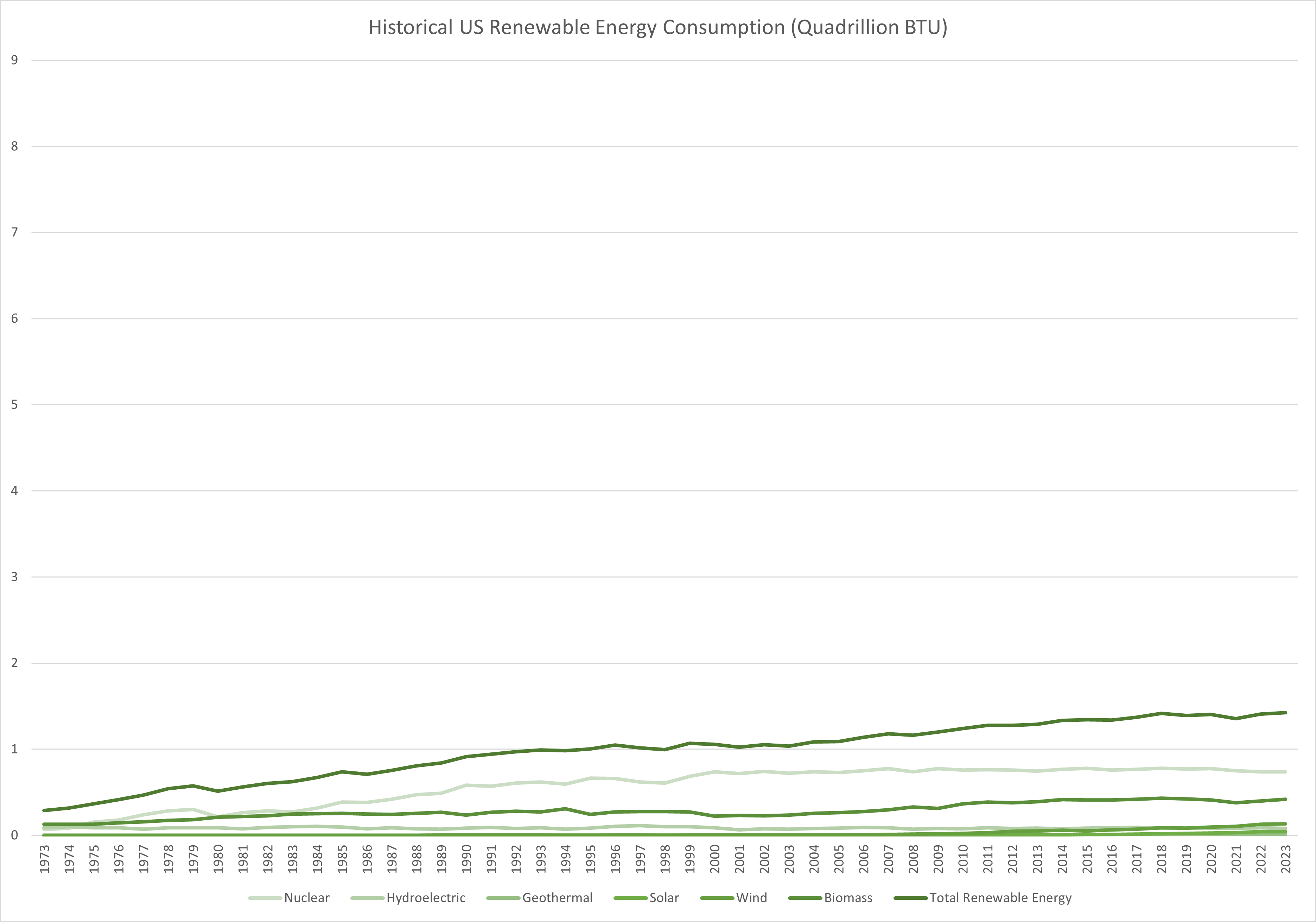
In the early 1970s, the United States’ electricity generation was heavily reliant on coal—a high carbon emitter—making the carbon footprint of electricity substantial. As the decades progressed, a shift began, prompted by environmental awareness, policy interventions, and economic factors. Natural gas, with its lower carbon intensity, started to replace coal in the energy mix, and nuclear power maintained a steady contribution, offering a low-carbon alternative to fossil fuels.
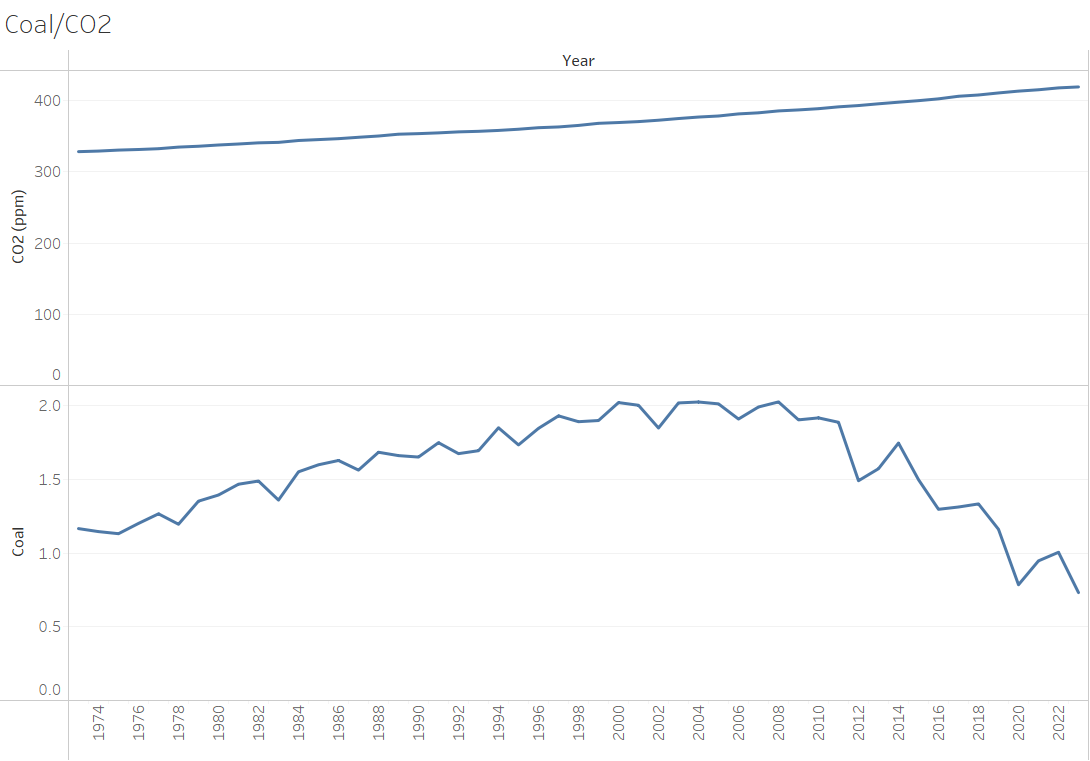
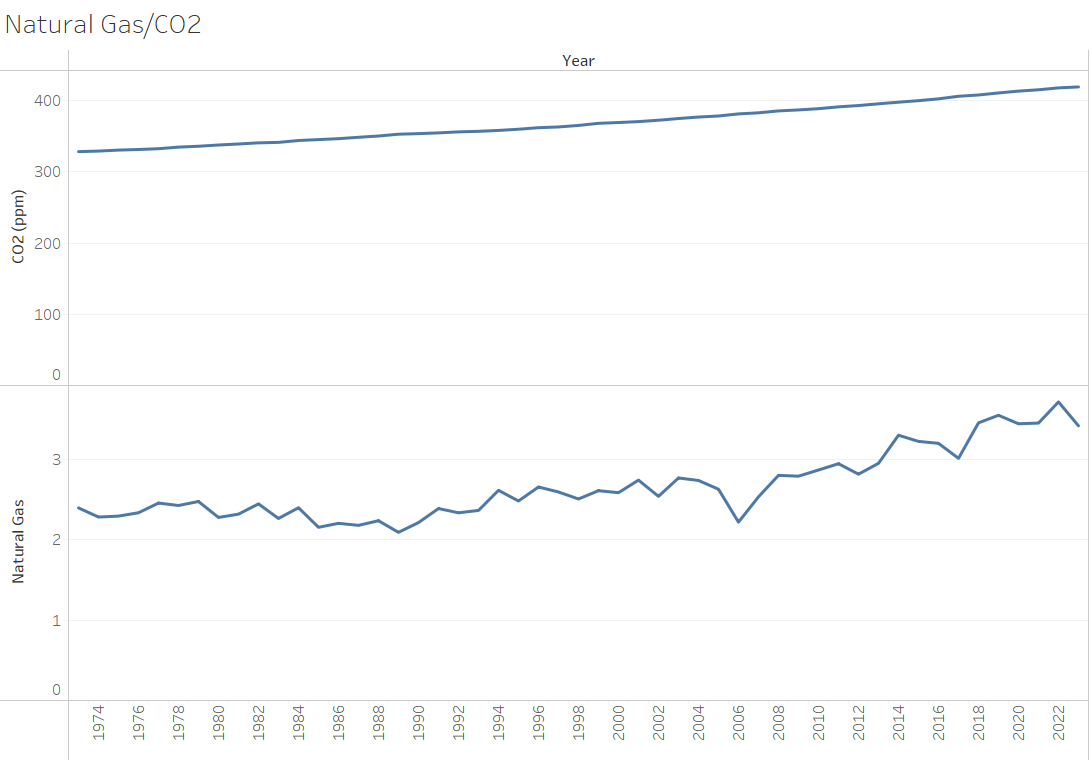
Renewable energy sources, once a nascent and negligible portion of the energy mix, have surged in the past fifty years. Wind, solar, and hydroelectric power, hitherto the underutilized trio of the energy sector, began to ascend in prominence. By 2023, these renewables have not only carved out a significant slice of the electricity production pie but have also fundamentally altered the carbon cost of electricity. The exponential growth in renewable capacity, driven by technological advances and declining costs, has introduced an era where electricity can be generated with minimal carbon emissions.
Yet, this transition to a lower-carbon electricity grid is not without its challenges. The intermittency of renewables and the need for storage solutions, the phase-out of aging infrastructure, and the balancing of grid reliability with sustainability goals—all represent hurdles on the path to decarbonization. Despite these challenges, the trajectory is clear: the United States is moving towards an electric grid that favors cleaner energy sources.
My project’s data visualizations offer a stark representation of this shift. I traced the descent of coal’s dominance, the rise of natural gas, and the breakthrough of renewables. Each kilowatt-hour of electricity is accounted for, not just in dollars and cents, but in the carbon it adds to our atmosphere. We lay bare the carbon intensity of various energy sources, from the hefty emissions of coal to the negligible carbon footprint of wind and solar, painting a picture of an electricity sector that is in the midst of a profound metamorphosis.
Charting the Future: The Next Steps in Combating Global CO2 Emissions
As we gaze into the horizon of a future where global CO2 emissions could potentially stabilize or even decline, the United States stands as both a major player and a poignant emblem of the global energy transition. The next steps in combating CO2 emissions require a bold reimagining of energy systems, an unwavering commitment to sustainable practices, and a collective will that transcends borders and ideologies.
The journey of the US energy sector over the last fifty years provides critical insights into the complexities of scaling down emissions. The rise in renewable energy adoption and the gradual decline of coal usage in electricity production have set the stage for a comprehensive strategy to combat CO2 emissions. Yet, the full potential of these shifts remains to be realized. The next steps involve not only accelerating the deployment of renewable technologies but also enhancing energy efficiency across industries and the built environment.
Innovative policy frameworks, technological advancements, and financial mechanisms must converge to create an ecosystem conducive to low-carbon growth. The United States, in collaboration with other nations, must invest in research and development to further reduce the costs of clean energy technologies, develop storage solutions to address intermittency issues, and expand the infrastructure for electric vehicles.
Internationally, the US can leverage its technological prowess and diplomatic influence to foster global partnerships aimed at reducing emissions. These partnerships could support developing countries in leapfrogging to sustainable technologies, promote the sharing of best practices, and create a global market that rewards carbon reduction.
The transition to a low-carbon future also requires a paradigm shift in consumer behavior and corporate governance. The notion of sustainability must be ingrained in the fabric of societal norms, and the corporate world must prioritize environmental considerations in their operations and investment decisions. Transparency in carbon accounting and the integration of carbon costs into financial analyses will be vital in driving this change.
Furthermore, climate change mitigation is not solely an environmental issue—it is an economic, social, and security concern. The ramifications of climate change, if left unaddressed, could reshape global economies, exacerbate social inequalities, and lead to geopolitical instability. Therefore, the steps toward reducing CO2 emissions are steps toward a more stable and equitable world.
Conclusion
The culmination of “The Carbon Footprint” project represents an extensive synthesis of research, data analysis, and creative design decisions, all aimed at illustrating the complex narrative of the United States’ energy consumption and its environmental implications over the past fifty years.
Throughout the project, I made deliberate design choices to translate intricate data into accessible and engaging visual stories. One such decision was to employ a blend of pie charts and line graphs, providing a visual representation of the evolution of the U.S. energy mix and the corresponding carbon emissions. The aim was to create a stark contrast between the heavy reliance on fossil fuels in 1973 and the diversified energy portfolio of 2023, highlighting not only the progress but also the remaining challenges.
An observation that stands out is the stark dichotomy between the growth of renewable energy sources and the persistent rise in CO2 emissions, reflecting the complexity of achieving a truly sustainable energy future. Despite the advances in renewable energy, the total energy demand and the persistent use of fossil fuels in absolute terms continue to drive up CO2 emissions. This paradox underscores the necessity for continued innovation and more aggressive policy interventions.
Design-wise, I focused on a clean and intuitive user interface that facilitates an understanding of the data without overwhelming the audience. Interactive elements were introduced to allow viewers to delve deeper into the data, fostering engagement and a better grasp of the subject matter.
Through interviews and feedback loops, I fine-tuned my narrative and visualizations to ensure they resonate with my target audience, which includes politician, policymakers, industry leaders, and the academic community. By tailoring the content to be both informative and actionable, I aspired to make “The Carbon Footprint” not just a repository of information, but a platform that can inspire real-world change.
In conclusion, “The Carbon Footprint” is more than a data visualization project; it is an advocacy tool designed to illuminate the path forward in combating global CO2 emissions. It is an invitation to policymakers, industry leaders, and citizens to engage with the data, understand the implications, and take action towards a sustainable and low-carbon future.
Intended Audience
The primary intended audience for “The Carbon Footprint” project encompasses a broad spectrum of environmentally conscious individuals, particularly those holding or aspiring to positions of influence within the energy and environmental policy spheres. This includes, but is not limited to, policymakers at the federal, state, and local levels in the United States, environmental advocates, industry decision-makers, and academics who specialize in climate change and sustainable development.
Policymakers, especially, are a crucial audience because of their unique position to enact change. They possess the authority to introduce and pass legislation that can significantly alter the course of energy production and consumption, not only within the United States but also in setting a precedent for global energy policies. The ‘why’ behind targeting this audience lies in the multiplicative effect that informed legislative actions can have. By equipping policymakers with clear, data-driven insights into the shifts in energy consumption and the carbon costs associated with electricity production, they can make more informed decisions that can lead to substantial reductions in CO2 emissions.
Moreover, as representatives of the public interest, politicians have the capacity to influence public opinion and lead by example. Their endorsement of renewable energy initiatives can mobilize public support and pave the way for larger-scale transformations in the energy sector. They can also serve as advocates for the United States on the international stage, promoting collaborative efforts to address climate change, which is a global challenge requiring a coordinated response.
The project also targets leaders in the energy industry, including executives of utility companies, renewable energy firms, and investment entities that fund energy projects. These individuals can directly impact the carbon footprint of electricity production through their investment choices and corporate strategies. By understanding the long-term implications and potential regulations, they can steer their companies towards more sustainable practices that align with a low-carbon future.
The secondary audience includes educators and the academic community who can influence the curriculum and discourse around climate change and sustainability. By incorporating the findings from this project into their teaching and research, they can inspire a new generation of environmentally savvy citizens and professionals.
The rationale for choosing an audience with the power to effect change is rooted in the project’s objective to not just inform but also to drive action. “The Carbon Footprint” project seeks to be more than an exposé of past and present trends; it aims to be a catalyst for future change, making the audience’s selection critical. By targeting those with the authority to implement policies, influence industry standards, and shape the educational narrative, the project endeavors to contribute meaningfully to the global fight against climate change.
Shorthand Presentation
The Carbon Footprint: Tracing the Impact of US Energy Production on Climate Change
References
- Evans, Simon, and Verner Viisainen. “Analysis: Global CO2 Emissions Could Peak as Soon as 2023, IEA Data Reveals.” Carbon Brief, 26 October 2023
- Hausfather, Zeke. “State of the Climate: Global Temperatures Throughout Mid-2023 Shatter Records.” Carbon Brief, 23 October 2023
- International Energy Agency. “Emissions Factors 2023.” IEA, September 2023
- Monroe, Robert. “Rise of Carbon Dioxide Unabated.” Scripps Institution of Oceanography, University of California San Diego, 4 June 2020
- Ritchie, Hannah, and Max Roser. “CO2 Emissions.” Our World in Data, 2023
- Schleeter, Ryan. “Global Carbon Emissions.” National Geographic Society, 19 October 2023
- World Meteorological Organization. “2023 Shatters Climate Records, with Major Impacts.” WMO, 30 November 2023
- World Meteorological Organization. “Provisional State of the Global Climate in 2023.” World Meteorological Organization, 30 November 2023